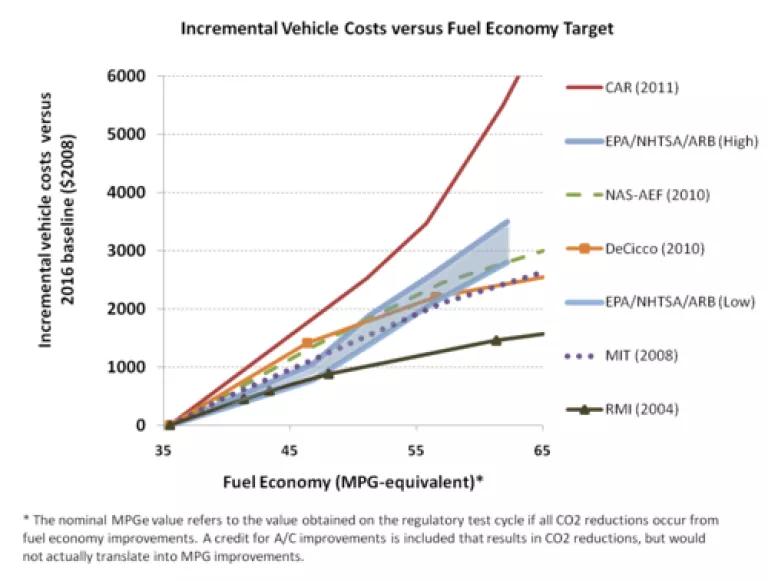Auto Industy Cries Wolf, the Sequel [Original Title: Three Reasons Why the Auto Industry's Fuel Economy Cost Claims are Wrong]
Just in time for summer, the auto industry has released their own version of the Hollywood standby, the sequel to the blockbuster disaster movie. In their version, the automaker lobbyists claim if President Obama requires their industry to double fuel efficiency over the next 14 years, cars will become unaffordable and workers will be tossed out of jobs. However, time and time again, the auto industry storyline that the sky will fall whether its air bags, seatbelts, or catalytic converters has proven to be wrong. [In a plot twist, the one notable exception is GM which says it will "find a way" to achieve 56.2 mpg.]
Automakers have the technology and the know-how to meet strong fuel economy standards, despite their protests to the media and the White House. Meeting strong standards does not require any breakthroughs in new technologies and only modest amounts of electric vehicles. The auto industry has a four decades long, well documented and not-so-proud history of exaggerating cost claims by 2 to 10 times. Their latest 3 times higher costs claims ring hollow when compared to latest peer-reviewed cost analysis of what can be achieved by 2025.
Reason #1: Technology to meet 56.2 mpg is well known and affordable
According to the analysis by the U.S. Environmental Protection Agency, Department of Transportation and California Air Resources Board, the technologies needed to meet strong standards are well-known, affordable and require no radical technical or cost breakthroughs. There are four key technologies that are needed to meet a 62 mpg standard:
- Lightweight, high strength materials to reduce mass 10 percent from 2016 levels, consistent with auto industry trends.
- Enhancing turbocharged gasoline engine efficiency by cooling and boosting the exhaust gas.
- Improved, lower-cost hybrids technologies called “parallel 2-clutch” systems that Hyundai, VW, Nissan are introducing now into the marketplace.
- Plug-in hybrids and battery electrics with lower cost, advanced lithium batteries.
The automakers claim to meet even just 56.2 mpg will require lots of electric vehicles. This is simply not true. The chart below is the show the average mix of the four technology pathways for different standards levels that the U.S. EPA, DOT and CARB developed. 56.2 mpg requires just 3 percent electric vehicles, and 62 mpg requires just 10 percent. Meeting the standard can be mostly done with improved gasoline turbocharged engines and hybrids.

Reason #2: Auto industry has a four decade long history of exaggerating costs
Past history would suggest that the auto industry current cost estimates are once again highly inflated. The chart below shows that the latest 3 times cost exaggeration falls perfectly in line with their historic claim of 2 to 10 times higher than the regulator estimates. And due to unanticipated innovation, the actual costs on key requirements have turned out even lower than regulators estimated.

Reason #3: Auto industry claims much higher than independent analysis
The chart below done is from my colleague Simon Mui’s blog. It shows that the agency costs estimates fall in the middle of the range between the auto industry study by the Center for Automotive Research (CAR 2011) and other independent, peer-reviewed studies.

According to his blog “The CAR 2011, relied upon by the auto industry [red solid line], far exceeds the range estimated by other studies” of long-term fuel economy potential including those by the National Academy of Sciences – America’s Energy Future (NAS-AEF 2010), Massachusetts Institute of Technology (MIT 2008), Dr. DeCicco at the University of Michigan (DeCicco 2010), and the Rocky Mountain Institute (RMI).
The reason for the cost differences? As explained in greater detail in a recent blog, the CAR 2011 cost study systematically overestimates the cost of achieving a 62 mpg standard by using a different baseline, ignoring low cost options and using out-of-date technology assumptions.
According to the agencies estimate, 62 mpg would cost $3,225 and but would save drivers $6,412 over the life of the vehicle, with a payback time of 3.8 years (all averages of the four technology pathways). The automakers claim the cost will be three times higher and require two thirds of the fleet to be plug in hybrids and battery electric vehicles. The gulf is wide. Who to believe? A closer look at the technology, other independent analysis, and the auto industry’s past history demonstrates that the auto industry is once again vastly exaggerating the cost of complying with new standards in order promote their latest disaster sequel.



